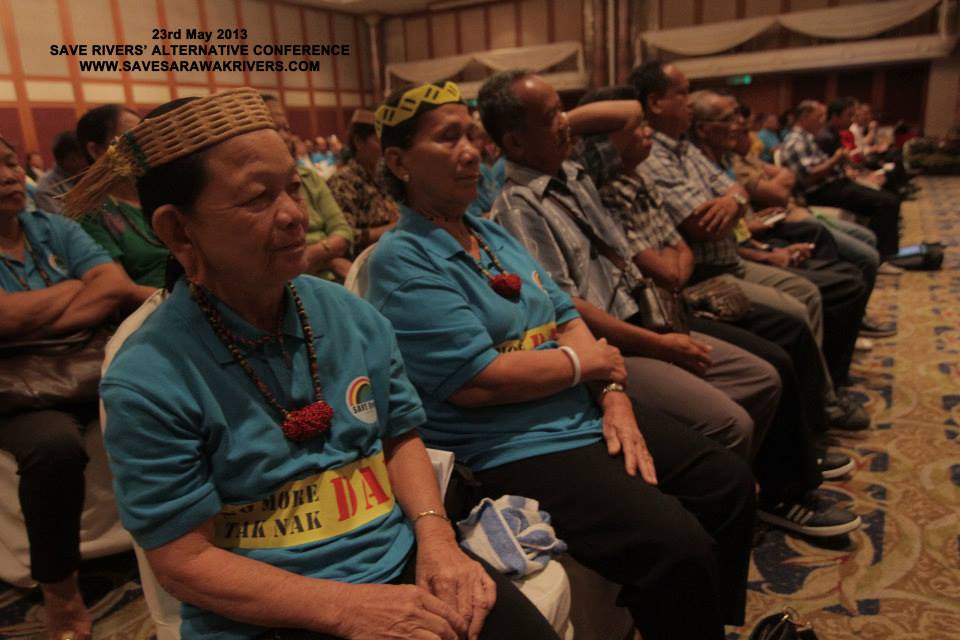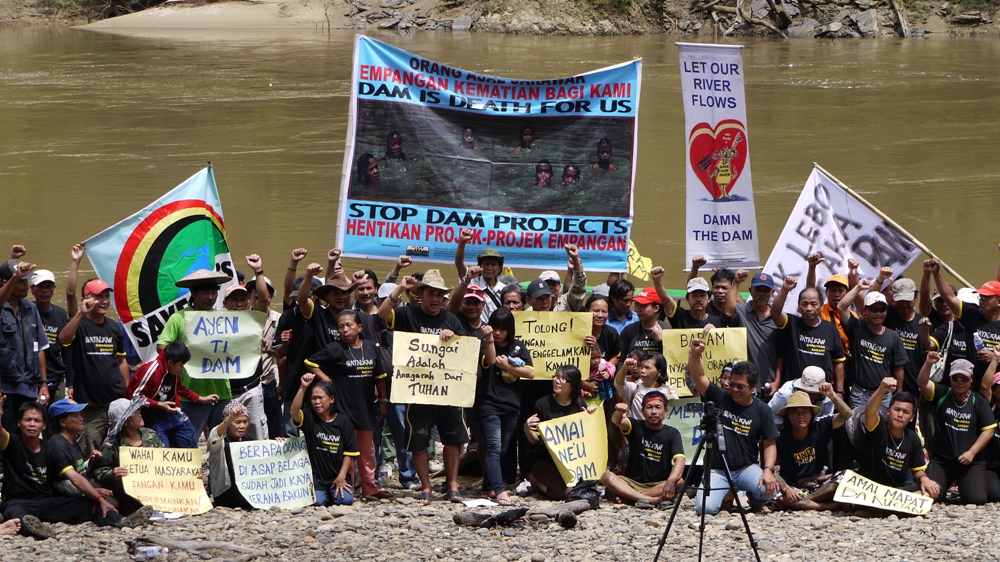Sarawak is a Malaysian state on the island of Borneo that is home to 40 groups of Indigenous Peoples. Vast expanses of land are divided up for logging operations, palm oil plantations and energy intensive industries, leaving only 11 percent of the state’s primary forests intact. A recent aerial mapping of the state has revealed that primary logging roads have a combined length of 88,111 km, equivalent to more than twice the Earth’s circumference. Over the past few decades, the Indigenous People who live in Sarawak’s forests have been confronted by a situation in which their rights to traditional lands have been extinguished, often without their knowledge.
 Indigenous people protest against the Sarawak dams (May 2013)
Indigenous people protest against the Sarawak dams (May 2013)
Sarawak’s rivers are also being sacrificed in the race to generate quick profits. In 2011, the Malaysian and Sarawak governments finished building the controversial Bakun Dam. More recently, the 944 MW Murum Dam was completed, but is not yet operational due to technical design flaws. The Sarawak government plans to complete at least 10 more dams by 2020 with the help of its state-owned company, Sarawak Energy Berhad (SEB). 10,000 Indigenous People were displaced to make way for the Bakun Dam. The construction of additional dams will lead to the dispossession of tens of thousands of Indigenous Peoples and irreversible devastation to the biodiversity of Sarawak’s ecosystems. Together, the dams will flood over 2,100 square kilometers of forest. In 2011, local indigenous leaders formed a grassroots movement called the SAVE Rivers Network to raise awareness and how the dams will harm forest-dependent communities.
Although the Bakun Dam is not operating at full capacity due to lack of demand for the energy, and the resettlement scheme has been widely acknowledged as a failure, the Sarawak government and SEB are proceeding with preparatory surveys and land acquisitions for additional dam projects. To demonstrate their opposition to the dams and demand that their right to free, prior and informed consent be respected, Indigenous People in Sarawak are organizing events in urban centres, such as Kuching and Kuala Lumpur, and also in their communities where the dams are being planned. The national Indigenous Peoples network, Jaringan Orang Asal SeMalaysia, along with SAVE Rivers and the national human rights organization, SUARAM, are helping to strengthen an emerging movement of Indigenous People affected by – and opposing – mega-dams in Sarawak and Peninsular Malaysia and to bring national attention to the ongoing rights violations at dam project resettlement sites.
- Sign the Petition to Stop the Sarawak Dams!
- Watch the video “Damming our Future” by The Borneo Project
Why are the dams being built?
Well documented evidence suggests that corruption is driving the rapid development of the dams in Sarawak. From 1981 until February 2014, the head of the Sarawak government was Chief Minister Abdul Taib Mahmud. As of March 2014, Taib stepped into the post of Governor of Sarwak, and his former brother-in-law took over as Chief Minister. In addition to being the main proponent of the hydro projects, Taib and his family have a controlling ownership stake in many of the local companies involved in the dams, such as Sarawak’s largest construction company Cahya Mata Sarawak Berhad, and also maintain control over Sarawak Energy Bhd. An investigation in March 2013 by Global Witness recorded several members of Taib’s family openly discussing corruption in the timber and land industry. Taib and his family not only hold controlling shares in the majority of Sarawak businesses but also have acquired ownership of companies and properties in North America, Europe and Australia.Charges of corruption against Taib and the Sarawak Energy Berhad have been brought to the attention oft the Malaysia Anti-Corruption Commission. as well as to anti-corruption bodies internationally, including the Norwegian anti-corruption agency (Økokrim).
The economic justification for the Sarawak dams does not add up. Together, the series of proposed dams would produce a total of 7,000 MW of electricity in Sarawak, although local energy demand is only projected to reach 1,500 MW by 2020. While the Bakun Dam is not running at full capacity, the completed Murum Dam is not functioning at all. The dams are part of what the Sarawak government calls the Sarawak Corridor of Renewable Energy (SCORE) initiative. According to Taib, SCORE will attract industrial investments to “transform Sarawak into a developed state” by 2020. The details of this plan have not been made available to the public.
 Indigenous groups meet in Sarawak to discuss the proposed dams (May 2013).
Indigenous groups meet in Sarawak to discuss the proposed dams (May 2013).
Legal protections for Indigenous People living in Sarawak are weak. The Sarawak government does not fully recognize indigenous people’s claims to traditional lands and also has powers to extinguish customary land rights with little prior notification. Many Malaysian court rulings in favor of Indigenous Peoples’ rights are not upheld in Sarawak, while violations of rights outlined in the national constitution are rampant.
In Sarawak, thousands of Indigenous People have not been issued identity cards, and therefore are denied access to basic health care, education, public services and the right to vote. Access to independent media is restricted, particularly in remote areas, meaning that communities to be affected by dams have very little information about the projects other than that conveyed by government and company representatives.
How will the dams impact Sarawak’s Indigenous Peoples?
The 2,400 MW Bakun Dam was completed in 2011 after nearly five decades of delays and labeled a “Monument of Corruption” by Transparency International. This dam forcefully resettled 10,000 Indigenous People in 1998. Ten years later, many of these people are living in extreme poverty.
Construction of the 944 MW Murum Dam is complete but impoundment of the dam’s reservoir and operational schedule are delayed due to technical problems with the operation of the turbines. The dam displaced approximately 1,500 people, who were resettled in 2013. The project has resulted in numerous violations of Indigenous Peoples’ rights under international law, yet it is being showcased by the International Hydropower Association as an example of ‘best practice’. Sarawak Energy Berhad did not begin the project’s environmental and social impact assessment until after construction was underway, and did not make the assessment available to the public. In 2012, Indigenous Peoples blockaded the construction site for one month after obtaining a leaked copy of the project’s resettlement plan, which showed unacceptable levels of compensation. The affected communities have been forced to negotiate the terms of their resettlement without having access to information about the dam’s impacts and without having independent legal and technical support. In an attempt to continue to draw public attention to the deplorable conditions at the resettlement site, affected families have continued to launch sporadic road blockades throughout the course of 2014.
 Only 5% of Sarawak’s primary forests remain, due to the rapid spread of logging and palm oil plantations.
Only 5% of Sarawak’s primary forests remain, due to the rapid spread of logging and palm oil plantations.
Another major project planned to be built by Sarawak Energy is the proposed 1,200 MW Baram Dam, which could displace up to 20,000 indigenous people and flood an area of 388 square kilometers. The Sarawak government has not yet formally approved the project, nor is the environmental and social impact assessment disclosed. Work on access roads to the dam site began but came to a halt in October 2013 when local communities launched two blockades to stop construction and other project preparations from proceeding. The Indigenous Kayan, Kenyah and Penan communities have held their ground, and have not let company trucks pass into the area. Feasibility studies have been completed for at least seven other dams, and it is unclear whether Sarawak Energy will shift their focus to another dam site if they assess local people would be less resistant.
What is China’s role?
The dams are being built by two Chinese state-owned companies. Sinohydro constructed the Bakun Dam. China Three Gorges Corporation and Sinohydro constructed the Murum Dam, and are expected to remain involved in subsequent projects. The Murum Dam is China Three Gorges’ first major overseas project. Neither company has taken an active role in the environmental or social management of the projects, nor has either company conducted any due diligence on the corruption risks posed by the dams.
Why is the international hydropower industry showcasing the Sarawak dams?
In May 2013, the International Hydropower Association (IHA) held its biannual world congress in Kuching, Sarawak. The government’s dam developer Sarawak Energy Berhad claims that it is building the dams “responsibly” because it is using the IHA’s new toolkit to manage the environmental and social risks of the Murum Dam. However, the Sarawak government has refused to make public the results of its IHA assessment, which reportedly highlights numerous shortcomings.
Now, the Asian Development Bank is considering a US $45 million loan to Sarawak Energy Bhd. to support the company in building transmission lines to evacuate power from Sarawak’s dams to West Kalimantan, Indonesia. Given SEB’s track record of charges of corruption and violations of Indigenous Peoples rights, it is questionable how SEB would comply with the bank’s social and environmental safeguard standards or integrity and anti-corruption guidelines.
More information
Background on the Dams in Sarawak
- Malaysians Call for Immediate Stop to Mega Dam Projects (10 Sept 2014)
- Campaign to Stop Baram Dam: Photos, Films and Updates from the Blockade (2014)
- Sarawak’s Murum Dam: What Has Changed Since the Indigenous Blockade? (Blog, 14 August 2013)
- Malaysia: Authoritarian Leader Lures Investors With Promise of “Responsible Dams” (Blog, 16 May 2013)
- Megadam Project Galvanizes Native Opposition in Malaysia (National Geographic, February 2013)
- Sold Down the River: How Sarawak Dam Plans Compromise the Future of Malaysia’s Indigenous Peoples (Bruno Manser Fonds, November 2012)
- HSAP Ineffective in Corrupt Sarawak Dams (Blog, 31 August 2012)
- Malaysia’s Murum Dam Sets Poor Precedent for Best Practices (Blog, 15 August 2012)
- Fooling China’s Dam Builders (ChinaDialogue article, 6 April 2012)
- Malaysia Human Rights Commission, Legal Perspectives on Native Customary Land Rights in Sarawak (2008)
Indigenous Peoples’ Mobilizations to Oppose Mega-Dams
- Protest Against Mega-Dams at Kuala Lumpur Convention Centre (Video, Sept. 2014)
- Campaign press statements from Jaringan Orang Asal Se Malaysia, SAVE Rivers, Bruno Manser Fund & International Rivers
- SAVE Sarawak Rivers movement
- Indigenous Protests at the Global Hydro Meeting in Sarawak (May 2013)
- Malaysia: What to Do When Indigenous Groups Blockade Your Dam (Blog, 19 October 2012)
- Indigenous Leaders Launch Campaign Against 12 Dams (Press Release, 21 February 2012)
Corruption in Sarawak
- Asian Development Bank Loan Will Go Straight To Taibs (Sarawak Report, 9 October, 2014)
- Examples of SEB contracts with evidence of corruption (2009-2014)
- Sarawak Energy Awarded US $226 Million in Contracts to Malaysian Chief Minister’s Family (Worldwire, 19 May 2013)
- Video: Inside Malaysia’s Shadow State (Global Witness, March 2013)
- Briefing: Inside Malaysia’s Shadow State: Backroom deals driving the destruction of Sarawak (Global Witness, March 2013)
- Indigenous Leaders File Corruption Complaint Against Malaysian Dam Builder (Blog, 8 September 2012)
Media Reports
- Sensitive Issues Barred in Sarawak Assembly (Free Malaysia Today, 23 May 2013)
- Was Cost-Benefit Analysis Done on the Dams? (Free Malaysia Today, 23 May 2013)
- Megadam Project Galvanizes Native Opposition in Malaysia (National Geographic, 27 February 2013)
- Reuters: Malaysia’s plan to dam its frontier for energy generates dismay (Reuters, December 2012)
- Mining Cancellation Throws Wrench into Sarawak Dam-Building Spree (Mongabay, 27 March 2012)
- Power, Profit, and Pollution: Dams and the Uncertain Future of Sarawak (Mongabay, 3 September 2009)
Contact us
- Maureen Harris – mharris@internationalrivers.org

